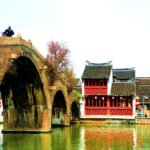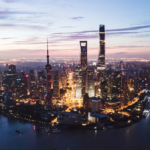Yongjiang Bridge is located in the urban area of Ningbo City, Zhejiang Province, and serves as an urban bridge connecting the Jiangbei and Jiangdong districts within the city.
The main bridge is an unequal span prestressed concrete single-tower cable-stayed bridge with a length of 105 + 97 meters, and the approach bridge adopts prestressed concrete hollow slab structures, with the entire bridge measuring 588.62 meters in length.

The total width of the main bridge deck is 26 meters, designed according to urban bridge standards. The carriageway is 15 meters wide, with pedestrian walkways on both sides each measuring 3 meters wide. A 2.25-meter safety cable zone is set between the carriageway and pedestrian walkways. The approach bridge deck is 21.5 meters wide.
The cable-stayed bridge features a fixed system of tower, piers, and beams. The two cable planes are arranged in a harp pattern with a cable spacing of 8 meters, and the entire bridge has a total of 11 pairs of cables. The stay cables are protected using domestically produced PE hot-extruded cable sheath processing technology.
The portal bridge tower stands at 52 meters high and has been artistically treated. The main beam features a semi-enclosed double-box section with a wind fairing, a beam height of 2 meters, a top width of 24 meters, side cantilevers of 2.5 meters, and a bottom width of 13 meters. A transverse beam is set every 4 meters, and three-dimensional prestressing is arranged.
The superstructure of the bridge is constructed using a cantilever hanging basket method. The main bridge tower and pier foundation consists of 32 bored piles with a diameter of 160 cm and a length of 65 meters, with the foundation slab measuring 35 meters in length, 15.5 meters in width, and 5 meters in height.
The bridge was completed and opened to traffic in June 1992. It was designed by Zhejiang Province Communications Survey and Design Institute and constructed by Shanghai Municipal Engineering Company. The bridge is open all year round, accessible 24 hours a day.







